St. Patrick and the celebrations on his March 17 feast day are famous around the world.
Images of a bearded man dressed in green robes holding a staff and some shamrock and stamping on a snake are plentiful around St. Patrick’s Day.
Growing up in Ireland, St. Patrick’s Day was always a big event and one that I always looked forward to each year.
I loved to make my own St. Patrick’s Day badge, which I then proudly wore to the St. Patrick’s Day Parade.
Even though it was part of the tradition in Ireland, I never really knew who St. Patrick was.
He is at the heart of Irish culture, mythology and legends, but not many people can answer the questions who is St. Patrick? Why did this man drastically change the course of Irish history?
And of course, why is St. Patrick connected with particular symbols such as the shamrock and snakes?
In this article we delve into the legends behind St. Patrick and separate fact from fiction.
This article may contain affiliate links. If you click on one of them, we might receive a small commission (at no extra cost to you). Thanks for your support to help us keep this site running!
Table of Contents
- 1 Who is St. Patrick?
- 2 St. Patrick Facts
- 3 What was Patrick’s real name?
- 4 When was St. Patrick born?
- 5 Nationality of St Patrick
- 6 Where was St Patrick born?
- 7 The Story of St Patrick
- 8 What is St Patrick known For?
- 9 St. Patrick’s Contribution to Irish Christianity
- 10 The Role of St. Patrick in Irish Folklore
- 11 St. Patrick FAQ
- 12 Discover Irish Culture
Who is St. Patrick?

St. Patrick was a missionary who traveled to Ireland to convert the pagans to Christiainty in the fifth century.
Most of the factual information we know about St. Patrick comes from two documents that he himself wrote.
These documents, The Confessio and the Epistola, give us a fascinating insight into the life of this far from ordinary man.
Bonus Tip: St. Patrick’s writings are also available in English here.
St. Patrick Facts
St. Patrick’s life and deeds have often been colored by myths and legends. Here are some reliable key facts that underpin the saint’s legacy:
- St. Patrick was not Irish. He spent time as a slave in Ireland during his younger years before escaping home to Britain.
- St. Patrick was not religious as a child and teenage and only became a devout Catholic during his time as a slave in Ireland.
- In his writings, he describes having dreams or visions. One of the most famous is that he felt a calling from the people of Ireland to return to the island and teach them about christianity.
- Ireland is one of the few countries in the world that is naturally snake free and has been since at least the last Ice age. So no, St. Patrick did not remove the snakes from Ireland.
- St. Patrick is believed to have died on March 17. This date is now his feast day and the national holiday of Ireland. St. Patrick’s Day parades take place on this day each year in many countries around the world including the United States, Canada and Australia.
What was Patrick’s real name?
In his own writings he only refers to himself as “Patricius”. This is the Latin name for Patrick and means “father of the people”.
However, history is rarely straightforward and Patrick is also referred to by some other names, including Maewyn Succat.
It is possible that the name Maewyn Succat was given to him centuries later by hagiographs who researched his life.
When was St. Patrick born?
There is very little evidence for any exact dates of his birth. However, historians believe that he was born towards the end of the fourth century.
His family was a wealthy British Roman one, who was well established in the community.
St. Patrick’s father was called Calpornius and was a type of local councilor and decon. His grandfather, Potitus, was a priest.
Nationality of St Patrick
Many questions have arisen regarding St. Patrick’s nationality.
He clearly stated at least three times in his writings that he comes from Britain and is of Roman British descent.
However, where exactly he was born is still a matter of debate.
Where was St Patrick born?
St. Patrick stated that he came from the island of Britain and lived in the British Roman settlement of Bannavem Taburniae.
This is where it gets a little tricky as the exact location of the settlement is difficult to pinpoint.
It is thought to be in the north west, probably close to the coast.
St. Patrick’s first language would have been Brythonic, or British Celtic.
This language would have been spoken on the west coast of Britain at the time and supports this idea.
The Story of St Patrick
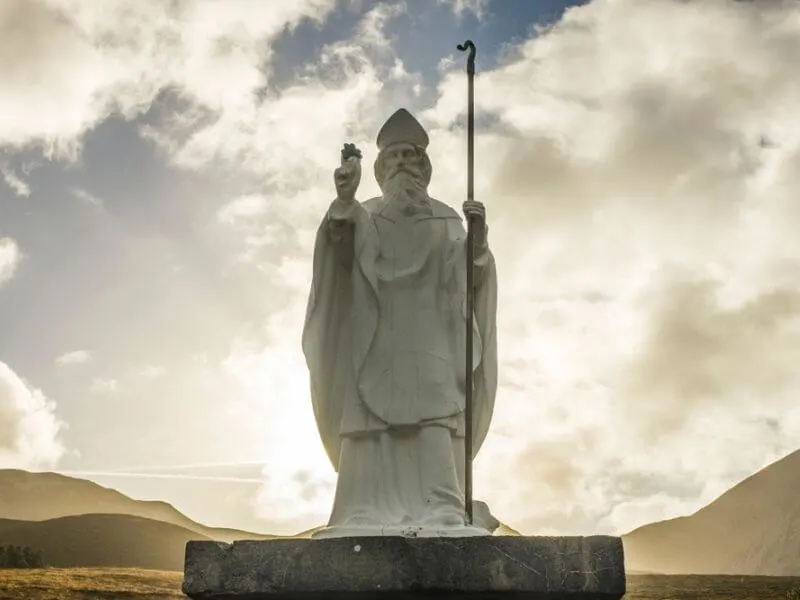
St. Patrick’s life story is a captivating one full of unexpected twists and turns.
It includes a dramatic abduction, escape and a strong sense of duty that compelled St. Patrick to go against the wishes of all those dear to him.
It feels like it is made for a movie!
St. Patrick Early Years
St. Patrick lived a good, relatively uneventful life until around the age of sixteen or thereabouts.
He claims not to have been particularly studious or religious during his early years. It was only during his time in captivity that he really turned to faith.
As his family were well connected in the community, he probably could have expected a decent career, possibly in politics.
His life took quite a dramatic turn when he was captured by Irish raiders and transported to Ireland.
St. Patrick the Slave
Once he arrived in Ireland, he was sold as a slave and transported to the western side of the country.
Evidence suggests that he spent about six years as a slave in the County Mayo area.
St. Patrick was tasked with looking after animals, such as sheep, cattle and also probably pigs. This was no easy job as he would have been outside in all sorts of weather.
(For anyone who is not familiar with Irish weather, the west coast of the county can be particularly wet, wild and windy!)
It was during these very hard, solitary times that St. Patrick turned to his faith for solace and guidance.
At some point during his time as a slave, St. Patrick had a dream about a boat that was waiting to take him home to Britain.
Taking this dream as divine inspiration, he decided to escape from his owner and try to return to his family.
He fled his master and traveled about 200 miles across Ireland. This grueling trip probably brought him to Wicklow or Wexford on the east coast of Ireland.
His next challenge was to convince a crew to take him on board.
At first he was refused passage, but eventually was allowed to join a ship.
This enabled him to leave Ireland and sail back to Britain.
Saint Patrick the Priest and Missionary
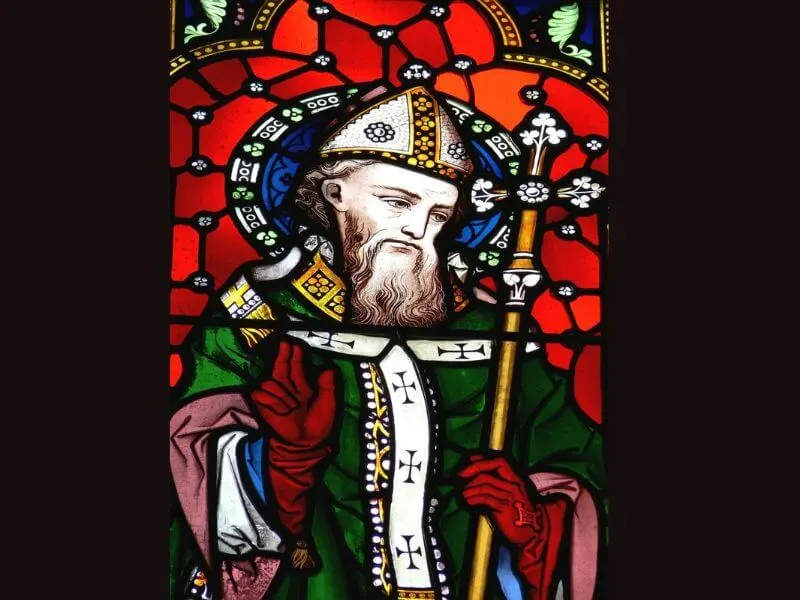
When in Britain, St. Patrick decided to become a priest. It is likely that he spent some time in France.
Despite all that he had been through in Ireland, he couldn’t forget about the country and its people.
He felt a particularly strong calling to go back to Ireland as a missionary and even dreamt of the people of Ireland delivering a letter to him.
When the clergy refused to upgrade St. Patrick to the rank of bishop, it appears that he endured a particularly hard time.
He then went against the wishes of his family, friends and his superiors and traveled back to Ireland in the role of a missionary.
Other missionaries had been in Ireland before St. Patrick, such as Palladius sent by Pope Celestine in the 5th century.
They did not have an in-depth understanding of the people and their culture so were not successful in converting the Irish population to Christianity.
Once he arrived in the country St. Patrick preached to the pagan Irish throughout Ireland.
His teachings were accepted by many leading to many new converts.
These people were baptized by St. Patrick and established little Christian communities.
It was a dangerous time for early Christians in Ireland. St. Patrick condemned a brutal attack on Irish Christains by a British pirate called Coroticus and his crew in the Epistola document.
St. Patrick’s safety was also not guaranteed in Ireland and he feared for his life at times. He risked martyrdom for his cause.
The Confessio was written by St. Patrick towards the end of his life.
In it he wrote about befriending kings and paying off a few higher members of society, such as judges, in order to keep the peace.
It also included details about his life and how he defended his actions for acting alone in bringing Christianity to the Irish.
During his own lifetime, he certainly was not seen as a missionary hero. If anything he was seen as a type of outcast by the clergy in Britain.
When did St. Patrick die?
It is believed that St. Patrick died on March 17.
There is speculation that he may have died around 461 AD.
However, given the lack of historical records it is not possible to verify this completely.
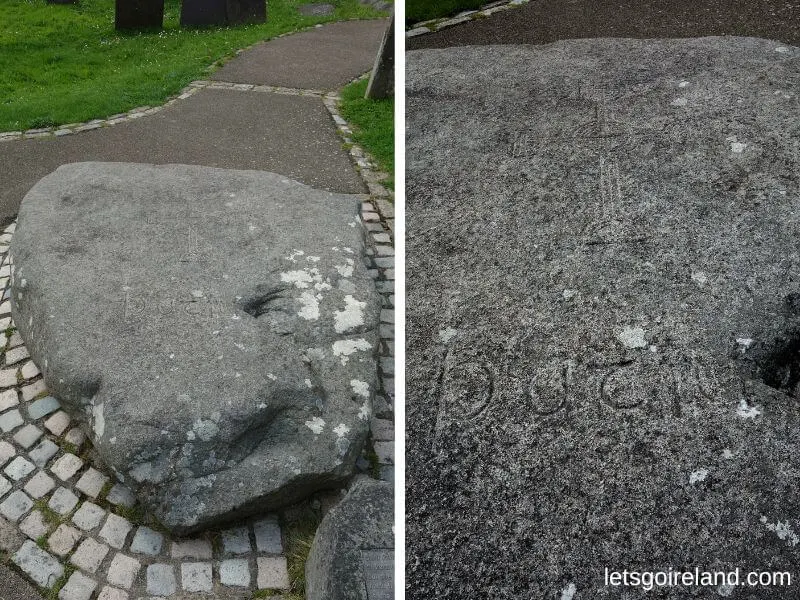
What is St Patrick known For?
St. Patrick is known for spreading Christianity through Ireland during the 5th century.
He is one of the three patron saints of Ireland and his feast day is celebrated on March 17th.
Parades to celebrate the saint and Irish culture take place on this day in Ireland and around the world.
Many famous legends and stories involve St. Patrick.
These include how he taught about the Holy Trinity in Christianity using the three leaves of a clover plant.
The tall tale that he banished the snakes from Ireland is another one!
What does the shamrock have to do with Saint Patrick?
St. Patrick is often depicted with shamrock. (What exactly is shamrock is another questions though!)
Supposedly he used this three leafed plant to explain the Holy Trinity concept of three beings in one.
The roots of this story do not date back to the time of St. Patrick, instead it is an invention from about the 17th century.
In Celtic tradition, three beings in one is somewhat common.
For example, the Morrigan Goddess of War and the Goddess Brigid of healing are triple Goddesses in Irish culture. Many symbols in Celtic art also focus on patterns of three.
Because of this, St. Patrick did not probably have a hard time explaining the idea of the Holy Trinity to the Irish people.
By the 17th century, it was common to wear crosses on the feast day of St. Patrick.
According to one account from the time, “vular” people instead opted to wear shamrock on this day. It is pretty strange how some traditions catch on, right?!
The Legend of St Patrick and Snakes
St. Patrick banishing the snakes from Ireland stands out as one of his famous deeds. However, Ireland has been snake free since glacial times.
So where did this legend come from? It is probably a 12th century metaphor of how St. Patrick helped Ireland to become Christian.
Ireland is an island.
After the last Ice Age, plants and animals had to re-colonize the country.
While three snake species colonized the neighboring island of Britain, no snakes established themselves in Ireland.
The conditions for snakes were not optimal and the landbridge was now closed by the Irish Sea.
As recently as the 1960s, slow worms (Anguis fragilis) deliberately reintroduced to the west of Ireland.
Given its appearance, it can be mistaken for a type of snake, but it is actually a legless lizard.
When Religion meets Science
On a field trip about the Burren Wildlife, I heard a tale of a very religious local man who was shocked to discover “snakes” in the area.
The reptiles that he had seen were not actually snakes in the true sense, but introduced slow worms.
This man was deeply troubled by this finding as he was fully convinced that St. Patrick had gotten rid of all of the snakes from Ireland.
St. Patrick’s Contribution to Irish Christianity
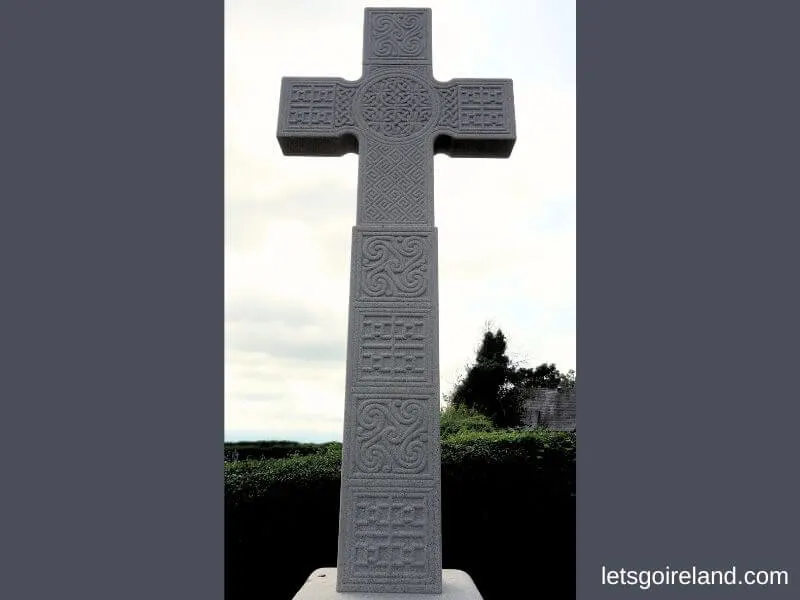
There is no doubt that St. Patrick contributed significantly to Irish Christianity.
Many deeds have been attributed to St. Patrick, but in reality, he may not have actually been responsible for many of them.
St. Patrick the Patron Saint
St. Patrick is the patron saint of Ireland, along with St. Brigid and St. Columba or Colmcille.
It is probably fair to say that St. Patrick is the most well known of the three.
Interestingly, St. Patrick was not canonized as saints are in the Catholic Church today.
The process to become a saint was different before the 10th century and did not involve a formal canonization process.
Decisions were made on a local level instead and did not involve the Pope.
St. Patrick and the Celtic Cross
The Celtic Cross is one of the symbols connected with St. Patrick.
He is said to have combined a Christian cross with the symbol of the sun, which resonated with the pagan Irish.
Celtic Cross designs were far more technical and complex than this and took centuries to develop.
Bonus Tip: Discover the famous Irish high crosses in this article.
St. Patrick and Croagh Patrick
Some legends say that St. Patrick climbed Croagh Patrick mountain in County Mayo and fasted there for forty days.
It is highly likely that this story is a fictional one created by the hagiograph Tírechán two centuries after St. Patrick.
Croagh Patrick has been the site of pilgrimages for centuries and continues to be a popular route on the last Sunday of July (aka Reek Sunday). This is around the time of the harvest celebration of Lughnasadh.
Some people opt to walk among the rocky stones as a form of penance.

(Note of Caution: I have climbed Croagh Patrick and the stones on the scree slopes are sharp. It is really not advisable to do this route without proper hiking boots!)
St. Patrick and the Early Catholic Church
Most of the knowledge we have about St. Patrick came from his own writings.
Even in the 9th century, his own writings were being censored by the Church.
This allowed the Irish Christians to create their own version of St. Patrick’s story.
(Copies of his original writings surface elsewhere in Europe, so this original uncensored content can be traced.)

The Role of St. Patrick in Irish Folklore
St. Patrick is not just a historical figure or a saint.
He is a part of Irish cultural identity and is woven into the heart of Irish folklore.
Stories of his deeds have been passed down through the generations.
It is not surprising then that he has gained mythical status with his many deeds!
There are certainly plenty of stories of him using shamrock in Christian teachings. Banishing the snakes from Ireland by driving them all off the cliffs is another well known tale.
In some versions of the Children of Lir legend, the swans were transformed back into humans only when they heard the ringing of St. Patrick’s bell.
St. Patrick was believed to have defied the High King by lighting the Paschal fire on the Hill of Slane.
Legend has it that this act of defiance of pagan tradition caused uproar.
Interestingly from what we know from his own writings, St. Patrick tried hard to get along with the local kings. (He even used their sons as his bodyguards while traveling through Ireland.)
St. Patrick writes that he tried to be respectful of the traditional cultural and social norms in the insular Irish society.
He would also have been familiar with the Irish language due to his long captivity in the country.
By not standing on too many toes, he probably helped the success of his own cause.
Many of these legends can be traced back to some of the hagiographs that later wrote about the life of St. Patrick.
Many of these had their own agendas and so created favorable tales of Patrick to suit their needs.
St. Patrick FAQ
What did St Patrick do?
St. Patrick was a missionary who spread Christianity to the pagan Irish in the 5th century.
Legend has it that he also banished snakes from Ireland and explained the Holy Trinity to the Irish with the use of a shamrock.
Yet there is even more to his fascinating life.
He was abducted as a teenager and sold into slavery by Irish pirates. Years later he escaped his owner and crossed Ireland by foot before sailing back to Britain by boat.
Later in his life he became a priest and spent some time in what is now present day France.
St. Patrick was directed in his dreams to return to Ireland and bring the Christian faith to the Irish.
Despite strong opposition from his superiors and family he traveled to Ireland to spread Christianity there.
What did St. Patrick do in the Bible?
St. Patrick lived in the 5th century and did not appear in the Bible.
However, the bible is frequently referenced in his writings and he also used it in his teachings about Christianity.
Whether he integrated natural symbols, such as the shamrock, into his teachings to explain the Christian doctrine is a matter of scholarly debate.
Was St Patrick Italian?
Given his Roman connections, one might be mistaken for thinking that St. Patrick had Italian connections.
This is not the case however.
St. Patrick was born on the island Britain, which at the time was under the influence of the Roman Empire.
This is why St. Patrick grew up surrounded by Roman culture.
As part of this he enjoyed a well-off lifestyle with servants in his grandfather’s countryside villa.
How did St Patrick die?
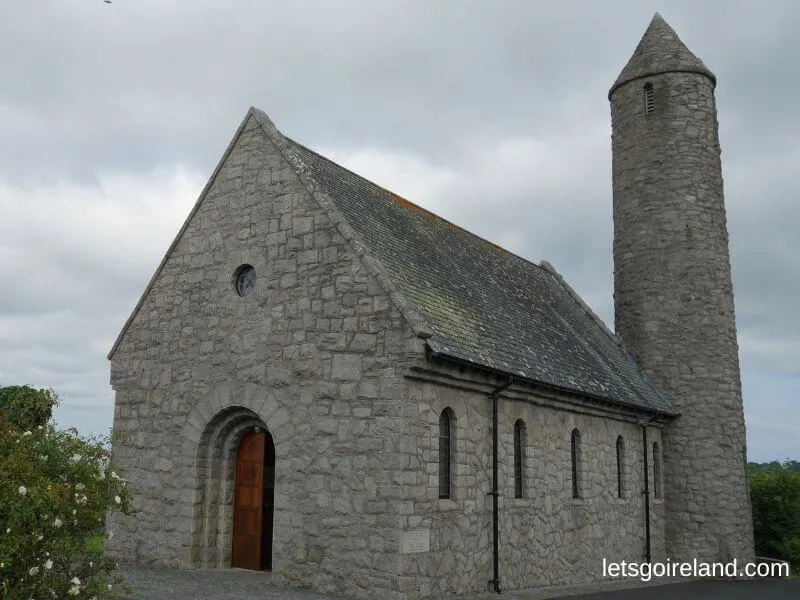
From his writings, we know that he must have reached a pretty good age for the very early medieval times.
As there is practically no information about his death, it is not really possible to say how St. Patrick died. Perhaps he just succumbed to old age?
Some accounts suggest he died peacefully at the monastery in Saul, the site of his first church in Ireland.
But like the majority of stories connected with St. Patrick, there could be a large amount of fiction associated with it.
Discover Irish Culture
Are you interested in finding out some more about Irish Culture?
here are some great ideas to get you started!
- What things are associated with Ireland?
- Do you know what symbols are connected with Ireland and why?
- Traditional Irish Blessings
